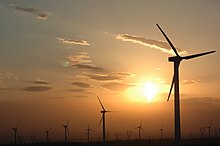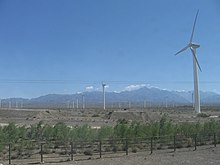Wind power in China

At the end of 2010, wind power in the People's Republic of China accounted for 41.8 gigawatts (GW) of electricity generating capacity,[1][2] and China has identified wind power as a key growth component of the country's economy.[3] With its large land mass and long coastline, China has exceptional wind resources.[4] Researchers from Harvard and Tsinghua University have found that China could meet all of their electricity demands from wind power through 2030.[5]
By the end of 2008, at least 15 Chinese companies were commercially producing wind turbines and several dozen more were producing components.[6] Turbine sizes of 1.5 MW to 3 MW became common. Leading wind power companies in China were Goldwind, Dongfang Electric, and Sinovel[7] along with most major foreign wind turbine manufacturers.[8] China also increased production of small-scale wind turbines to about 80,000 turbines (80 MW) in 2008. Through all these developments, the Chinese wind industry appeared unaffected by the global financial crisis, according to industry observers.[7]
In 2010, China became the largest wind energy provider worldwide, with the installed wind power capacity reaching 41.8 GW at the end of 2010. According to the Global Wind Energy Council, the development of wind energy in China, in terms of scale and rhythm, is absolutely unparalleled in the world. The National People's Congress permanent committee passed a law that requires the Chinese energy companies to purchase all the electricity produced by the renewable energy sector.[1]
History

The primary domestic wind turbine manufacturer in China is Goldwind (金风科技股份有限公司) from Xinjiang province. Established in 1998, Goldwind has been aggressively developing new technology and expanding its market share, accounting for 35% in 2006.[9][10]
Of the total of 80 wind farms presently operating in China, the China Longyuan Electric Power Group Corp., a wholly owned subsidiary of China Guodian Group Corp., operates 32 wind farms in China; these 32 wind farms have 952 wind turbines that cumulatively have installed capacity of 780 MW, or approximately 30% of total wind generating capacity in China.[11]
Chinese developers unveiled the world’s first permanent Maglev wind turbine at the Wind Power Asia Exhibition 2006 held June 28 in Beijing. Chinese company Zhongke Hengyuan Energy Technology invested CN¥400 million in building the base for the maglev wind turbine generators, in which construction began in November 2007. The company expects a yearly revenue of CN¥1.6 billion from the generators. But, because claimed capability of their Maglev Wind turbine clearly broke physical laws, it's believed that the announcement of it was hoax or viral marketing attempt.
According to reports from the 2007 China (Shanghai) International Wind Energy Exhibition held on April 10, 2007 at the Shanghai New International Exhibition Center, by 2010, 5% of Shanghai’s energy needs will be generated from wind power. Shanghai’s first domestically produced wind farm will locate in Lingang New Town; the 7 MW wind farm will begin generating power in early 2008 and the power generated from this wind farm will be connected to the Huadong Eastern China Power Grid. Over the past several years new wind farms have been built in Shanghai, including the Nanhui Wind Farm, the Qinjian Bay Wind Farm and the Chongming Dongtan (Eastern Beaches) Wind Farm. Together these three wind farms have 18 windmills with a total of 24.4 MW.
In 2006 the Shanghai Power Company purchased 64.485 million kW·h of green energy (primarily from wind farms), yet the amount of renewable energy which was subscribed by customers from Shanghai Power Company was only 23% of that total. In 2006 there were just 6,482 households in Shanghai that subscribed to renewable energy in part because the cost of wind power is 0.53 Yuan/kW·h higher than power produced from coal plants; in 2007 total output of wind farms in Shanghai will total 100 million kW·h, which is sufficient to power 120,000 households. Though there were 22 entities that purchased renewable energy in Shanghai, though with the exception of 1/3 of that total being state owned enterprises, the remainder was foreign invested enterprises. Shanghai’s city government did not purchase any renewable energy. Of the top ten power customers in Shanghai, only Bao Steel purchased renewable energy; in 2006 Bao Steel entered into an agreement to purchase 1.2 million kW·h over three years.[12]
The China National Offshore Oil Corporation (CNOOC), aiming to diversify from its core oil and gas business, will be seeking international companies interested in cooperating with them to develop offshore wind farms, said CNNOOC president Fu Chengyu at a conference in Hainan Province on April 22, 2007.[13]
The nearest wind farm to China's capital is Guanting, about 90 minutes drive from the city centre near the Badaling section of the Great Wall. Although it is small — 47 wind turbines, it is set to grow to 100 turbines by next year.[14]
Offshore wind
Construction of the first offshore wind farm in China started in April 2009, close to Shanghai Dongdaqiao. The wind farm is scheduled to be completed by the end of 2009 and to provide electricity to the 2010 Shanghai Expo. The wind farm will consist of 34 wind turbines, each of 3 MW capacity.[4]
Future wind farms
The Gansu Wind Farm proposed for western Gansu province is one of six national wind power megaprojects approved by the Chinese government. It is expected to grow to 20,000 MW by 2020, at an estimated cost of 120 billion Chinese yuan ($17.5 billion). In 2008, construction began on a 750 kV AC power line to carry electricity from the wind farm.[15]
Stability and cost
The increasing penetration of wind power has exacerbated the problems of delivering reliable power to users. “Because wind energy is unstable, it is a pollutant and affects the safety of the power grid,” said Hu Xueha, the deputy chief engineer of China’s Power Grid Research Institute. Furthermore, the transmission capacity of the grid hasn't kept up with the growth of China's wind farms. According to recent data from the China Power Union, only 72% (8.94 GW) of China’s total wind power capacity was connected to the grid.[16] In addition, increasing China's wind power capacity means increasing coal use as well, to provide power when the wind isn't available. "China will need to add a substantial amount of coal-fired power capacity by 2020 in line with its expanding economy, and the idea is to bring some of the capacity earlier than necessary in order to facilitate the wind-power transmission," according to Shi Pengfei, vice president of the Chinese Wind Power Association.[17] Shi is also concerned about the high cost of wind power, which makes the industry dependent on the government's willingness to subsidize renewable power. "It isn't that wind power is showing signs of over-heating. It has already overheated."[18]
See also
References
- ^ a b http://www.platts.com/RSSFeedDetailedNews/RSSFeed/ElectricPower/6773195
- ^ Lars Kroldrup. Gains in Global Wind Capacity Reported Green Inc., February 15, 2010.
- ^ Gow, David (2009-02-03). "Wind power becomes Europe's fastest growing energy source". London: Guardian. Retrieved 2010-01-31.
- ^ a b Oceans of Opportunity: Harnessing Europe’s largest domestic energy resource pp. 18-19.
- ^ "China Could Replace Coal with Wind". Ecogeek.org. Retrieved 2010-01-31.
- ^ "Caprotti Federico (2009) China's Cleantech Landscape: The Renewable Energy Technology Paradox ''Sustainable Development Law & Policy '' Spring 2009: 6–10" (PDF). Retrieved 2010-01-31.
- ^ a b REN21 (2009). Renewables Global Status Report: 2009 Update p. 16.
- ^ Adrian Lema and K. Ruby, “Towards a policy model for climate change mitigation: China's experience with wind power development and lessons for developing countries”, Energy for Sustainable Development, Vol. 10, Issue 4.
- ^ http://cn.goldwind.cn/en/index.asp
- ^ Lema, Adrian and Kristian Ruby, ”Between fragmented authoritarianism and policy coordination: Creating a Chinese market for wind energy”, Energy Policy, Vol. 35, Issue 7, July 2007.
- ^ "Wind Energy Businesses in China". Energy.sourceguides.com. Retrieved 2010-01-31.
- ^ "Operation of quoting and bidding system in Shanghai power generation market" (PDF). Ieeexplore.ieee.org. 2003-09-12. Retrieved 2010-01-31.
- ^ "Datang wins first offshore wind farm". .cei.gov.cn. 2006-12-30. Retrieved 2010-01-31.
- ^ "Greenpeace China visits Guanting". Greenpeace.org. 2003-03-17. Retrieved 2010-01-31.
- ^ Peter Fairley. China's Potent Wind Potential Technology Review, September 14, 2009.
- ^ Xina Xie (July 30, 2009). "Great Leap Forward for China's Wind Energy". Energy Tribune. Retrieved 2009-08-01.
{{cite news}}: Check date values in:|date=(help); Unknown parameter|coauthors=ignored (|author=suggested) (help) - ^ Jing Yang (September 28, 2009). "China's Wind Farms Come With a Catch: Coal Plants". The Wall Street Journal. Retrieved 2009-09-28.
{{cite news}}: Check date values in:|date=(help) - ^ Lu Zhenhua (July 31, 2009). "Wind power growth in China's deserts ignored financial risks". 21st Century Business Herald. Retrieved 2010-05-22.
{{cite web}}: Check date values in:|date=(help) (Reprinted in The Guardian, May 14, 2010.)
External links
- Wind Power China (Chinese)
- Chinese Wind Energy Association (Chinese)
- China Wind Systems Announces Completion of Large Scale Manufacturing Facility for Wind Components
- China wind power report 2007 (Greenpeace China)
- China wind power capacity growing
- China Wind Systems Begins Producing Forged Products at New Facility
- China Outlines Clean Power Blueprint
- World Wind Energy Association
